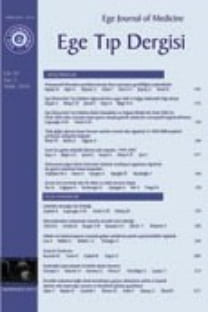Renal arterlerin değerlendirilmesinde kontraslı 3D anjiografi'nin rolü ve Doppler USG ile korelasyonu
Ultrasonografi, doppler, renkli, Daralma, patolojik, Tanı teknikleri, ürolojik, Renal arter, Manyetik rezonans anjiyografi
Contrast-enhanced three-dimensional MR angiography in the assesment of renal artery stenosis and correlation with color Doppler sonography
Ultrasonography, Doppler, Color, Constriction, Pathologic, Diagnostic Techniques, Urological, Renal Artery, Magnetic Resonance Angiography,
___
- 1. Dean RH. Renovascular hypertension: an overvievv. İn: Rutherford RB, ed. Vascular surgery. 3rd ed. Philedelphia, Pa: Saunders,1989;1211-1218.
- 2. Working group on renovascular hypertension. Detection, evaluation, and treatment of renovascular hypertension: final report. ArchIntern Med 1987; 147:820-829.
- 3. Abrams Angiography on CD-ROM. Version 2.13 (11-14-97). Copyright 1987-1997 by Lippincott-Raven Publishers.
- 4. Bakker J, Beek FJA, Beutler JJ, et al. Renal artery stenosis and accessory renal arteries: Accuracy of detection and visualizationwith gadolinium-enhanced breath-hold MR angiography. Radiology 1998; 207:497-504.
- 5. Strandness DE. Natural history of renal artery stenosis. Am J Kidney Dis 1994;24:630-635.
- 6. Lossino F, Zuccala A, Busato F, Zucchelli P. Renal artery angioplasty for renovascular hypertension and preservation of renalfunction: long-term angiographic and clinical follow-up. AJR 1994; 162:853-857
- 7. Harden PN, Macleod MJ, Rodger RSC, et al. Effect of renal-artery stenting on progression of renovascular renal failure. Lancet1997; 349:1133-1136.
- 8. Hillman BJ. Imaging advances in the diagnosis of renovascular hypertension. AJR 1989; 153:5-14.
- 9. Gilfeather M, Yoon HC, Siegelman ES, et al. Renal artery stenosis: Evaluation with conventional angiography versus gadolinium-enhanced MR angiography. Radiology 1999; 210:367-372.
- 10. Postma CT, van Aalen J, de Boo T, Rosenbusch G, Thien T. Doppler ultrasound scanning in the detection of renal artery stenosis inhypertensive patients. Br J Radiol 1992;65:857-860.
- 11. Rieumont MJ, Kaufman JA, Geller SC, et al. Evaluation of renal artery stenosis with dynamic gadolinium-enhanced MRangiography. AJR Am J Roentgenol 1997; 169:39-44.
- 12. Thornton MJ, Thornton F, O'Callaghan J, et al. Evaluation of dynamic gadolinium-enhanced breath hold MR angiography in thediagnosis of renal artery stenosis. AJR Am J Roentgenol 1999;173:1279-1283.
- 13. Beregi J-P, Elkohen M, Deklunder G, Artaud D, Coullet JM, Wattinne L. Helical CT angiography compared with arteriography in thedetection of renal artery stenosis. AJR 1996;167-495-501.
- 14. Prince MR. Gadolinium-enhanced MR aortography. Radiology. 1994; 191: 155-164.
- 15. Debatin JF, Ting RH, Wegmüller H, et al. Renal artery blood flow: quantification with phase contrast imaging with and vvithoutbreath-holding. Radiology 1994; 190:371-378.
- 16. Prince MR, Narasimham DL, Stanley JC, et aî. Breath-hold gadolinium-enhanced MR angiography of the abdominal aorta and majorbranches. Radiology 1995; 197:785-792.
- 17. Hahn U, Miller S, Nagele T, et al. Renal MR angiography at 1.0T: Three-dimensional (3D) phase-contrast tecniques versusgadolinium-enhanced 3D fast low-angle shot breath-hold imaging. AJR Am J Roentgenol 1999;172:1501-1508.
- ISSN: 1016-9113
- Yayın Aralığı: 4
- Başlangıç: 1962
- Yayıncı: Ersin HACIOĞLU
Adrenal myelolipom: Olgu sunumu
Ali ER, Eyüp KEBAPÇI, C. Suat EREN, Özgür ÖZTEKİN, Ali ÖLMEZOĞLU
Overin matür kistik teratomunda tiroid papiller karsinomu: Bir olgu sunumu
Sevil SAYHAN, Tahir ÖZGÜDER, Nilgün DİCLE, Mustafa YAMAZHAN
ÖMER KİTİŞ, Cem ÇALLI, Gülgün DEMİRPOLAT, Mustafa PARILDAR, M. Refik KİLLİ, Nilgün YÜNTEN
Serdar ENER, Beyza ENER, Halis AKALIN
Meral KOYUNCUOĞLU, MUSTAFA PEHLİVAN, SACİDE PEHLİVAN, Ziya KIRKALI
Parapsoriasis plağında topikal fotodinamik tedavi
Can CEYLAN, Fezal ÖZDEMİR, Alican KAZANDI
Peripartum intramüsküler metoklopramid uygulamasının postpartum laktasyon başlama zamanına etkisi
Tevfik YOLDEMİR, Başak BAKSU, Ahmet VAROLAN, Aydın Ayşe KARA, Aysun ALTINTAŞ, İnci DAVAS
Hüseyin YILMAZ, Hayal ÖZKILIÇ, İnci GÜNER, A. Mete ERGENOĞLU
ABDURRAHİM DERBENT, Melek SAKARYA, Aylin DERBENT, Ali Reşat MORAL
